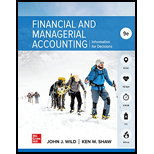
Financial and Managerial Accounting
9th Edition
ISBN: 9781264098583
Author: Wild, John J.
Publisher: MCGRAW-HILL HIGHER EDUCATION
expand_more
expand_more
format_list_bulleted
Concept explainers
Question
Chapter 1, Problem 10E
a.
To determine
To compute: The value of equity.
b.
To determine
To compute: The value of equity.
c.
To determine
To compute: Beginning and ending amount of equity
Expert Solution & Answer
Trending nowThis is a popular solution!

Students have asked these similar questions
I want to this question answer for General accounting question not need ai solution
Can you solve this financial accounting problem using accurate calculation methods?
Can you explain the process for solving this financial accounting question accurately?
Chapter 1 Solutions
Financial and Managerial Accounting
Ch. 1 - Prob. 1QSCh. 1 - Prob. 2QSCh. 1 - Prob. 3QSCh. 1 - Prob. 4QSCh. 1 - Prob. 5QSCh. 1 - Prob. 6QSCh. 1 - Applying the accounting equation A1 Total assets...Ch. 1 - Applying the accounting equation A1 Use the...Ch. 1 - Prob. 9QSCh. 1 - Identifying effects of transactions using...
Ch. 1 - Identifying effects of transactions using...Ch. 1 - Prob. 12QSCh. 1 - Prob. 13QSCh. 1 - Identifying assets, liabilities, and equity P2...Ch. 1 - Prob. 15QSCh. 1 - Prob. 16QSCh. 1 - Prob. 17QSCh. 1 - Prob. 18QSCh. 1 - Prob. 19QSCh. 1 - Prob. 20QSCh. 1 - Prob. 21QSCh. 1 - Prob. 1ECh. 1 - Exercise 1-2 Identifying accounting users and uses...Ch. 1 - Prob. 3ECh. 1 - Prob. 4ECh. 1 - Prob. 5ECh. 1 - Prob. 6ECh. 1 - Prob. 7ECh. 1 - Prob. 8ECh. 1 - Exercise 1-8 Using the accounting equation A1...Ch. 1 - Exercise 1-9 Using the accounting equation...Ch. 1 - Prob. 11ECh. 1 - Exercise 1-10 Analysis using the accounting...Ch. 1 - Exercise 1-11 Identifying effects of transactions...Ch. 1 - Prob. 14ECh. 1 - Exercise 1-13 Identifying effects of transactions...Ch. 1 - Prob. 16ECh. 1 - Prob. 17ECh. 1 - Prob. 18ECh. 1 - Prob. 19ECh. 1 - Prob. 20ECh. 1 - Prob. 21ECh. 1 - Prob. 22ECh. 1 - Prob. 23ECh. 1 - Prob. 24ECh. 1 - Prob. 25ECh. 1 - Problem 1-1A Identifying effects of transactions...Ch. 1 - Problem 1-2A Computing missing information using...Ch. 1 - Prob. 3PSACh. 1 - Problem 1-4A preparing a statement of retained...Ch. 1 - Problem 1-5A Preparing a balances sheet P2
Use the...Ch. 1 - Problem 1-6A Preparing a statement of cash flows...Ch. 1 - Problem 1-7A Analyzing transactions and preparing...Ch. 1 - Problem 1-8.4 Analyzing effects of transactions C4...Ch. 1 - Prob. 9PSACh. 1 - Prob. 10PSACh. 1 - Prob. 11PSACh. 1 - Prob. 1PSBCh. 1 - Problem 1-2B Computing missing information using...Ch. 1 - Prob. 3PSBCh. 1 - Prob. 4PSBCh. 1 - Problem 1-5B Preparing a balance sheet P2 Use the...Ch. 1 - Prob. 6PSBCh. 1 - Prob. 7PSBCh. 1 - Problem 1-8B Analyzing effects of transactions C4...Ch. 1 - Prob. 9PSBCh. 1 - Prob. 10PSBCh. 1 - Prob. 11PSBCh. 1 - Prob. 1SPCh. 1 - Prob. 1.1AACh. 1 - Prob. 1.2AACh. 1 - Prob. 1.3AACh. 1 - Prob. 1.4AACh. 1 - Prob. 2.1AACh. 1 - Prob. 2.2AACh. 1 - Prob. 2.3AACh. 1 - Prob. 2.4AACh. 1 - Prob. 2.5AACh. 1 - Prob. 3.1AACh. 1 - Prob. 3.2AACh. 1 - Prob. 3.3AACh. 1 - Prob. 1DQCh. 1 - Technology is increasing used to process...Ch. 1 - Prob. 3DQCh. 1 - What are at least three questions business owners...Ch. 1 - Prob. 5DQCh. 1 - Describe the internal role of accounting for...Ch. 1 - 7. Identify three types of services typically...Ch. 1 - Prob. 8DQCh. 1 - Prob. 9DQCh. 1 - 10. What are some accounting-related professions?
Ch. 1 - Prob. 11DQCh. 1 - Prob. 12DQCh. 1 - Prob. 13DQCh. 1 - Prob. 14DQCh. 1 - Prob. 15DQCh. 1 - Prob. 16DQCh. 1 - Prob. 17DQCh. 1 - Prob. 18DQCh. 1 - Prob. 19DQCh. 1 - Prob. 20DQCh. 1 - Prob. 21DQCh. 1 - Prob. 22DQCh. 1 - Prob. 23DQCh. 1 - Prob. 24DQCh. 1 - Prob. 25DQCh. 1 - Prob. 26DQCh. 1 - Prob. 27DQCh. 1 - Define and explain return on assets.Ch. 1 - Prob. 1BTNCh. 1 - Prob. 2BTNCh. 1 - Prob. 3BTNCh. 1 - Prob. 4BTN
Knowledge Booster
Learn more about
Need a deep-dive on the concept behind this application? Look no further. Learn more about this topic, accounting and related others by exploring similar questions and additional content below.Similar questions
arrow_back_ios
SEE MORE QUESTIONS
arrow_forward_ios
Recommended textbooks for you

 AccountingAccountingISBN:9781337272094Author:WARREN, Carl S., Reeve, James M., Duchac, Jonathan E.Publisher:Cengage Learning,
AccountingAccountingISBN:9781337272094Author:WARREN, Carl S., Reeve, James M., Duchac, Jonathan E.Publisher:Cengage Learning, Accounting Information SystemsAccountingISBN:9781337619202Author:Hall, James A.Publisher:Cengage Learning,
Accounting Information SystemsAccountingISBN:9781337619202Author:Hall, James A.Publisher:Cengage Learning, Horngren's Cost Accounting: A Managerial Emphasis...AccountingISBN:9780134475585Author:Srikant M. Datar, Madhav V. RajanPublisher:PEARSON
Horngren's Cost Accounting: A Managerial Emphasis...AccountingISBN:9780134475585Author:Srikant M. Datar, Madhav V. RajanPublisher:PEARSON Intermediate AccountingAccountingISBN:9781259722660Author:J. David Spiceland, Mark W. Nelson, Wayne M ThomasPublisher:McGraw-Hill Education
Intermediate AccountingAccountingISBN:9781259722660Author:J. David Spiceland, Mark W. Nelson, Wayne M ThomasPublisher:McGraw-Hill Education Financial and Managerial AccountingAccountingISBN:9781259726705Author:John J Wild, Ken W. Shaw, Barbara Chiappetta Fundamental Accounting PrinciplesPublisher:McGraw-Hill Education
Financial and Managerial AccountingAccountingISBN:9781259726705Author:John J Wild, Ken W. Shaw, Barbara Chiappetta Fundamental Accounting PrinciplesPublisher:McGraw-Hill Education


Accounting
Accounting
ISBN:9781337272094
Author:WARREN, Carl S., Reeve, James M., Duchac, Jonathan E.
Publisher:Cengage Learning,

Accounting Information Systems
Accounting
ISBN:9781337619202
Author:Hall, James A.
Publisher:Cengage Learning,

Horngren's Cost Accounting: A Managerial Emphasis...
Accounting
ISBN:9780134475585
Author:Srikant M. Datar, Madhav V. Rajan
Publisher:PEARSON

Intermediate Accounting
Accounting
ISBN:9781259722660
Author:J. David Spiceland, Mark W. Nelson, Wayne M Thomas
Publisher:McGraw-Hill Education

Financial and Managerial Accounting
Accounting
ISBN:9781259726705
Author:John J Wild, Ken W. Shaw, Barbara Chiappetta Fundamental Accounting Principles
Publisher:McGraw-Hill Education
The ACCOUNTING EQUATION For BEGINNERS; Author: Accounting Stuff;https://www.youtube.com/watch?v=56xscQ4viWE;License: Standard Youtube License